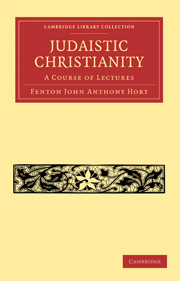Book contents
- Frontmatter
- PREFACE
- Contents
- I INTRODUCTORY LECTURE
- II CHRIST AND THE LAW
- III THE EARLY CHURCH AT JERUSALEM
- IV THE CHURCH OF ANTIOCH
- V THE INDEPENDENT ACTIVITY OF ST PAUL
- VI ST PAUL AT JERUSALEM AND THE EPISTLES OF THE ROMAN CAPTIVITY
- VII THE PASTORAL EPISTLES
- VIII JAMES, I PETER, HEBREWS, APOCALYPSE
- IX THE CHURCH OF JERUSALEM FROM TITUS TO HADRIAN
- X THE JUDAIZERS OF THE IGNATIAN EPISTLES
- XI CERINTHUS, ‘BARNABAS,’ JUSTIN MARTYR
- XII PALESTINIAN EBIONITES
- APPENDIX
- INDEX
IV - THE CHURCH OF ANTIOCH
Published online by Cambridge University Press: 07 September 2011
- Frontmatter
- PREFACE
- Contents
- I INTRODUCTORY LECTURE
- II CHRIST AND THE LAW
- III THE EARLY CHURCH AT JERUSALEM
- IV THE CHURCH OF ANTIOCH
- V THE INDEPENDENT ACTIVITY OF ST PAUL
- VI ST PAUL AT JERUSALEM AND THE EPISTLES OF THE ROMAN CAPTIVITY
- VII THE PASTORAL EPISTLES
- VIII JAMES, I PETER, HEBREWS, APOCALYPSE
- IX THE CHURCH OF JERUSALEM FROM TITUS TO HADRIAN
- X THE JUDAIZERS OF THE IGNATIAN EPISTLES
- XI CERINTHUS, ‘BARNABAS,’ JUSTIN MARTYR
- XII PALESTINIAN EBIONITES
- APPENDIX
- INDEX
Summary
The contribution from Antioch
The principal work of the Church of Jerusalem was now done. Henceforward we hear of it only incidentally, in so far as it had an influence on the expanding Church beyond Palestine. The transition is formed by a mission of Barnabas and Saul from Antioch to Jerusalem to carry a contribution to the brethren of Judea who were suffering from famine. This visit of St Paul to Jerusalem is passed over in his own recital in Galatians, but a sufficient explanation is given by Dr Lightfoot, and is indeed suggested by the structure of the narrative in Acts.
At the same time, doubtless before Barnabas and Saul arrived, a new form of persecution broke out. This time it came neither from people, nor from priests, nor scribes, nor elders, but from the king, from Herod. He slew James the son of Zebedee and imprisoned Peter, who was released by an angel, and withdrew, apparently for a time only, to another place.
James the Lord's brother
The death of James probably led to the substitution of James the Lord's brother in his place. He has not been named in the Acts till now, when he suddenly appears as the person to whom, in conjunction with the brethren, Peter sends the message with the account of his delivery from prison. From this time forward he is apparently the head of the Church of Jerusalem, and thus assumes a position of great interest in relation to our subject.
- Type
- Chapter
- Information
- Judaistic ChristianityA Course of Lectures, pp. 61 - 83Publisher: Cambridge University PressPrint publication year: 2009First published in: 1894



